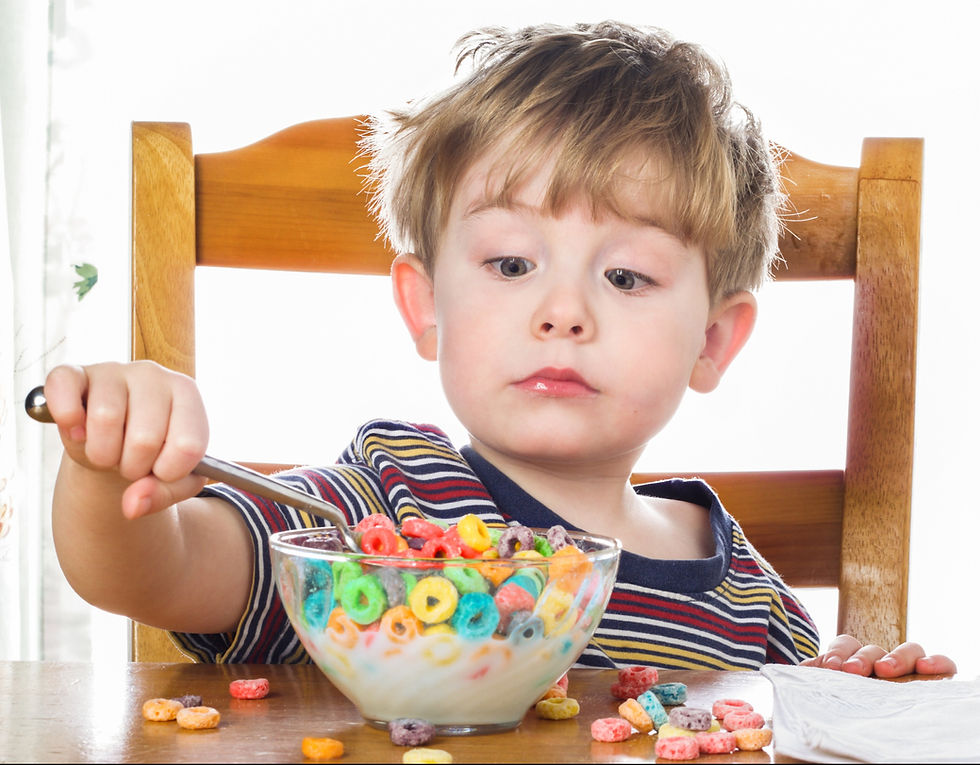Food Colourings Under Fire:In the news
- info848287
- Jul 8
- 4 min read

We are naturally attracted to brightly coloured foods, because fruits and vegetables are most nutritious when they are ripe and deeply coloured: think tomatoes, strawberries, peppers, blueberries. That’s when they are tastiest and sweetest too, and least likely to give us a stomach ache. It has even been proven that the intensity of the colour of a food influences our perception of its flavour!
Industrial food manufacturers have made profitable use of this evolutionary trait to make their foods more attractive. They colour their food products more brightly and intensely than natural ones, in some cases almost freakishly so. And yet intense colours such as bright blue or fluorescent pink, that adults might shy away from, are so very appealing to children.
A 2018 study acknowledged that there is insufficient or missing information on food colourings and their impacts on the health of children and infants. And children, the very people who are most attracted to these, are the ones needing the best nourishment to grow healthy bodies and brains, and also the most vulnerable to those possible negative impacts.
Food colourings have long been used to make something synthetic look more natural. When margarine was initially brought to market it was white. Consumers balked, so manufacturers added a golden yellow food colouring to make it look like butter. Likewise red dye is added to strawberry jam to make it look (and to some, taste) fruitier.
Many synthetic food colourings are made from petroleum, and have historically not required much research to allow them in processed foods. They are certainly devoid of any nutritional benefit, unlike the healthy phytochemicals that naturally colour our ripe fruits and vegetables. Nor do they help preserve the food or benefit the consumer’s health in any way.
Synthetic food colourings are also cheaper and more stable than natural ones, so they work well for mass production of ultra-processed foods designed for a long shelf life. And when a competitor’s synthetically coloured food grabs our attention, and sells better, the commercial pressure is on everyone else to follow suit, filling supermarket shelves with more and more bright orange cheezies and cherry red fruit punch.
Some colourings aren’t allowed in cosmetics because of their potential toxicity but are not banned in foods in the same country, because different regulations apply to foods and cosmetics! Where’s the sense in that? And different synthetic colourings are banned in different countries, so the same manufacturer will colour their products accordingly to supply to various countries! This is now the case with the US comparing their brightly-coloured breakfast cereals with those duller ones sold in Canada and Europe.
Canada’s list of permitted foods says colourants may be added if used singly or sparingly. If used in combination, the total amount is regulated, or it can be used according to good manufacturing practices.
In Europe, bans and warnings vary from country to country. The biochemistry of the consumers is no different, it’s only the rules that change. However, you should know that the list of banned synthetic colourings is much shorter than the list of allowed ones in almost all countries that regulate them. While Europe allows fewer food colourings, it still allows many suspect ones, albeit some now carry health warnings. In Sweden most candies use natural colourings and flavourings. You can ask for the ones with synthetic additives, but they will come with a warning about their potential health concerns, rather like cigarette packs here!
Although only a very small amount is used in any one food, it is estimated that annually, more than 8 million tons of more than 2000 types of synthetic dyes are used in foods across the world.
Given that these chemicals haven’t been rigorously evaluated, what do we know about the effects of synthetic food colourings?
Many studies indicate that artificial colours are directly associated with various disease conditions. These include food allergies (including eczema), gastrointestinal and respiratory problems (such as asthma), and even cancer. Behavioural changes in children have also been demonstrated. Children withAutism Spectrum Disorder were some of the most impacted, but children who hadn’t been diagnosed with any condition were also found to demonstrate behavioural changes after consuming food colourings.
Hyperactivity and ADHD were the focus of the diet proposed by the pediatric allergist Dr. Benjamin Feingold in the 1970s. Avoidance of synthetic colourings and flavourings reduced symptoms in a significant proportion of hyperactive children. Hyperactivity is a complex problem, and his diet was not a panacea for all hyperactive children. However cleaning up a child’s diet can only benefit them and might be a real solution, so it’s worth the time and effort for parents of a hyperactive child to try this medication-free, health-promoting approach.
Recently, there has been much discussion about using natural food additives that may improve human health instead of those that are potentially harmful. The idea is to use exclusively nontoxic, plant-based food additives, which are safe for our health. And believe it or not, Kraft Cheese Dinner has proven that it is possible: in 2016 it converted from synthetic to natural colourings using turmeric, paprika and annatto!





Comments